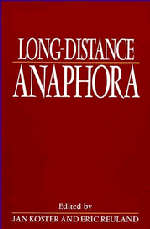Book contents
- Frontmatter
- Contents
- List of contributors
- Preface
- 1 Long-distance anaphora: an overview
- 2 Containment and connectedness anaphors
- 3 Long-distance reflexives and the typology of NPs
- 4 Contextual determination of the anaphor/pronominal distinction
- 5 On the interaction between antecedent-government and binding: the case of long-distance reflexivization
- 6 Binding in Polish
- 7 Anaphors in binary trees: an analysis of Czech reflexives
- 8 Latin long-distance anaphora
- 9 Prepositions, binding and θ-marking
- 10 Locality, parameters and some issues in Italian syntax
- 11 Long-distance binding in Finnish
- 12 The primacy condition of anaphora and pronominal variable binding
- 13 The local nature of the long-distance reflexive in Chinese
- 14 Anaphors and logophors: an argument structure perspective
- References
- Index
14 - Anaphors and logophors: an argument structure perspective
Published online by Cambridge University Press: 01 June 2011
- Frontmatter
- Contents
- List of contributors
- Preface
- 1 Long-distance anaphora: an overview
- 2 Containment and connectedness anaphors
- 3 Long-distance reflexives and the typology of NPs
- 4 Contextual determination of the anaphor/pronominal distinction
- 5 On the interaction between antecedent-government and binding: the case of long-distance reflexivization
- 6 Binding in Polish
- 7 Anaphors in binary trees: an analysis of Czech reflexives
- 8 Latin long-distance anaphora
- 9 Prepositions, binding and θ-marking
- 10 Locality, parameters and some issues in Italian syntax
- 11 Long-distance binding in Finnish
- 12 The primacy condition of anaphora and pronominal variable binding
- 13 The local nature of the long-distance reflexive in Chinese
- 14 Anaphors and logophors: an argument structure perspective
- References
- Index
Summary
Introduction
It has been known for quite some time that the binding theory developed in Chomsky (1981) and subsequent work does not account for the full range of binding facts (cf. Maling (1982), Giorgi (1984), Chomsky (1986a), Everaert (1986a), and others): The scope of conditions A and B is limited to binding within the domain of the first accessible subject, the local domain. Therefore, non-clausebounded reflexives, which are commonly referred to as long-distance (LD-) anaphors in languages as diverse as Icelandic, Finnish, Polish, Latin, Chinese, Japanese, etc., cannot be captured (see the various contributions in this volume for discussion and references). Even within the domain to which conditions A and B apply, language does not fully live up to their predictions. In a number of environments pronouns can be found where condition B excludes them. Well-known examples are English sentences of the type John saw the snake near him, reflexive verbs in Dutch and French which allow locally bound first and second person pronouns in object position, and Frisian, where this latitude also obtains with third person object pronouns (see Everaert (chapter 4), and Bouchard (1984)).
For years, a unified theory of the various anaphors across languages seemed somewhat unfeasible, in view of the massive differences reported concerning their distribution, particularly in the case of LD-anaphors. A major breakthrough, however, has been the discovery that a distinction is needed between logophoric processes and structural binding relations.
- Type
- Chapter
- Information
- Long Distance Anaphora , pp. 283 - 322Publisher: Cambridge University PressPrint publication year: 1991
- 50
- Cited by



